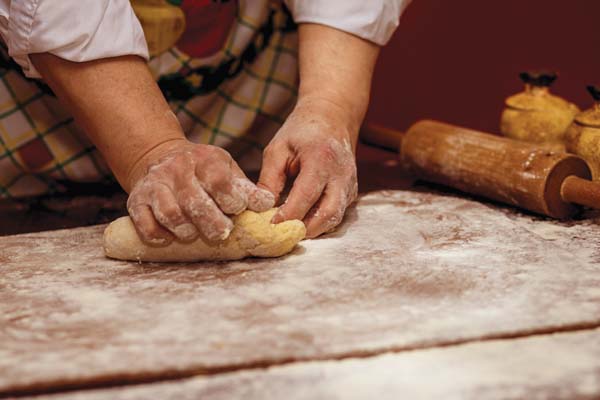Freshly made, wood-fired pizza isn’t just for restaurants anymore
Nothing beats a pizza, right? There are as many variations on this delicious dish as there are individuals, it seems, and that includes everything from the type of crust and toppings to how it’s cooked.
To some aficionados, the most perfect of pizzas are made in a dedicated, wood-fired pizza oven. Others swear by a traditional indoor oven with a cast iron pan or a pizza stone. But the allure of cooking pizza outdoors is winning more and more fans—whether using a wood-fired or pellet-fueled pizza oven or a charcoal or propane grill, once you have tried a pizza cooked outdoors, you’ll be hooked!
When you hear the term wood-fired pizza oven, your thoughts may go to a traditional half-circle, elaborate construct requiring masonry work, a lot of space—and a significant cash outlay. This may seem like a bit of overkill for many of us who might want to make a pizza for the family outside a few times a year. Happily, there are many different choices on the market and, best of all, if you have a sheltered deck or other outdoor space, you can cook pizza outdoors all year long—just as you can barbecue or smoke foods throughout the year.
Bill Harvie of Valley Stove and Cycle says his company is just getting into offering outdoor pizza ovens. “We have a couple of Fornetto wood-fired pizza ovens here, which can be used for a variety of purposes—smoking, baking or even rotisserie cooking.” He says they are a new product for his company and “we’re not sure where this is going to go in terms of popularity.” He also carries pellet grills from Green Mountain Grills, which use food-grade wood pellets as fuel, and which are also becoming popular for grilling pizza. “The pellets come in different hardwood flavours—mesquite, hickory, apple wood and others,” he says, “and they add greatly to the flavour of whatever you’re smoking or grilling—including pizza.”

Photo credit Bigstock/ yasnesone4ko
Diane McMaster operates Vintage Stove and Fireplace in Hilden, NS and specializes in fireplaces, barbecues and grills using all sorts of different fuels. One of the most popular grills she sells is the Japanese-inspired Kamado Joe, an oval, ceramic grill that’s fueled using natural, hardwood lump charcoal. Diane says, “These grills are great for anything you could want to cook; they can be controlled to a low heat for smoking or a high heat for searing steak or quickly cooking pizza.” The secret is in the hardwood charcoal, which is, as the name suggests, pure charcoal made from hardwoods—no fillers, detritus or chemicals like those sometimes found in the formed charcoal briquettes sold everywhere. “It burns hot, it burns clean, and it doesn’t take a huge amount to do a cook.”
Another option that Diane offers is the Uuni portable pizza oven. Weighing about 25 pounds, it’s ideal for a small deck area, or for taking with you on camping expeditions. Like the Green Mountain Grill, “the Uuni uses food-grade wood pellets,” she says. “Just a couple of cups will fill the hopper, and it takes only a few minutes to get the oven up to 930°F degrees (500°C).” The oven comes with a stainless-steel pizza peel, so you make your pizza indoors, slip the peel under it and into the oven, and in only a minute or two the dish is done! You have turn the pizza a couple of times while cooking, but you don’t lose heat when you open the door the way you do with a barbecue type cooker, so it stays at that high heat and cooks beautifully. Diane is finding these units are very popular, with a prize point that is affordable to most. “By the time you had a mason build a wood-fired pizza oven in your yard, you’d spend thousands,” she says. “We’re finding our customers are loving these portable, reasonably priced ovens—and the pizza that come out of them!” As an added bonus, you can cook other items in this oven—it apparently does a marvelous job searing steaks, for example.
Opinions vary on how to actually cook pizza on a grill. Some makes and models offer a ceramic pizza stone or deep-dish stone as an accessory, where you assemble the pizza on the stone and then place it in the grill to cook. There are, of course, those hard-core aficionados who like to grill the pizza directly on the grates, but this takes skill—first to grease the grates with the flame off, then to cook the pizza dough on one side for several minutes, flip it over, dress it and return it to the grill for a few more minutes. That seems like a lot of tricky work to me and an invitation for over- or under-cooking, so I prefer to use a pizza stone, which makes it easier to get the pizza on and off the grill, too.
One caveat—or perhaps two. Don’t bother trying to grill a frozen pizza on a barbecue or in a pizza oven. They’ll just get burnt from the outside and you’ll be disappointed—especially if you put a frozen pizza on a hot pizza stone and break the stone.
And as much as possible, use fresh pizza dough, not pre-made and pre-cooked rounds from a grocery store. It might take a little work to make dough from scratch, but you’ll really taste the difference.
